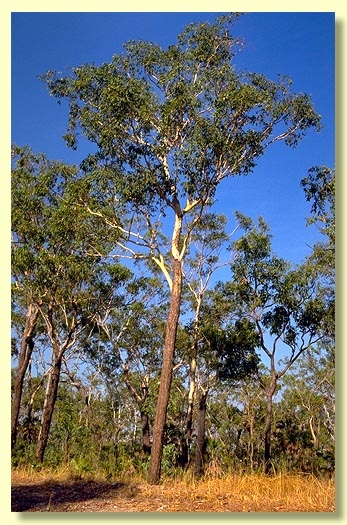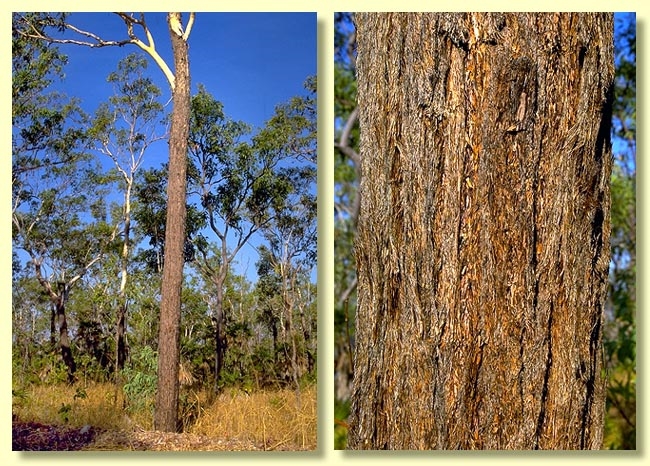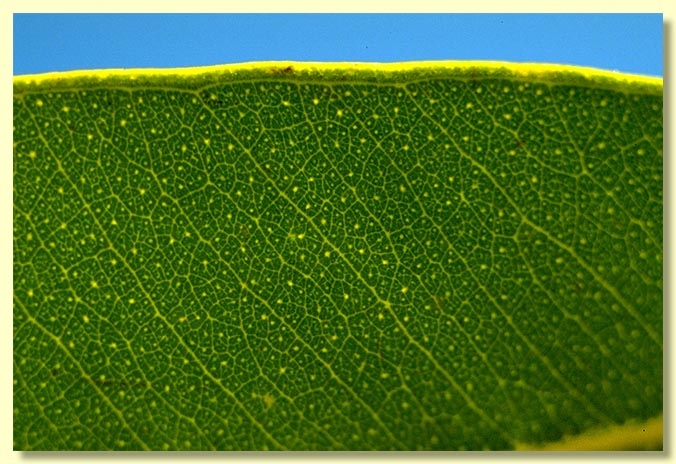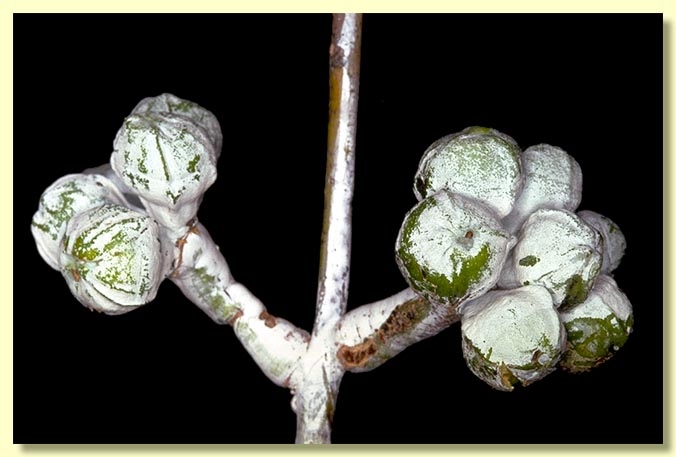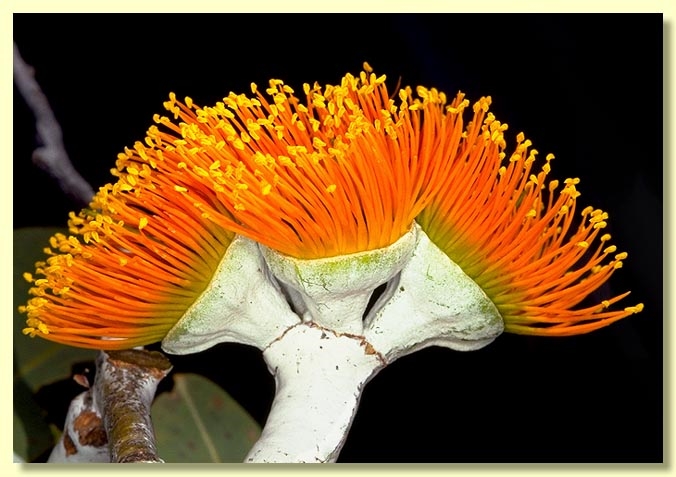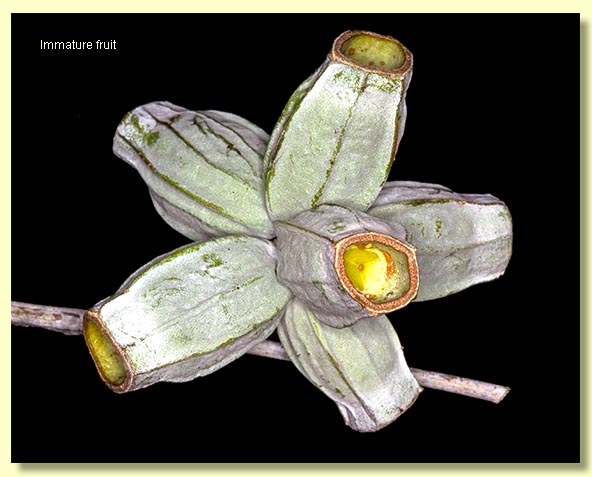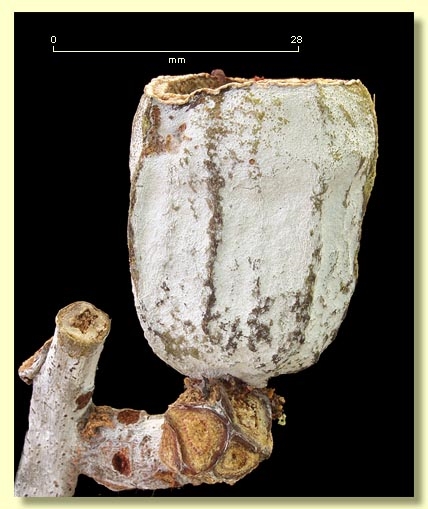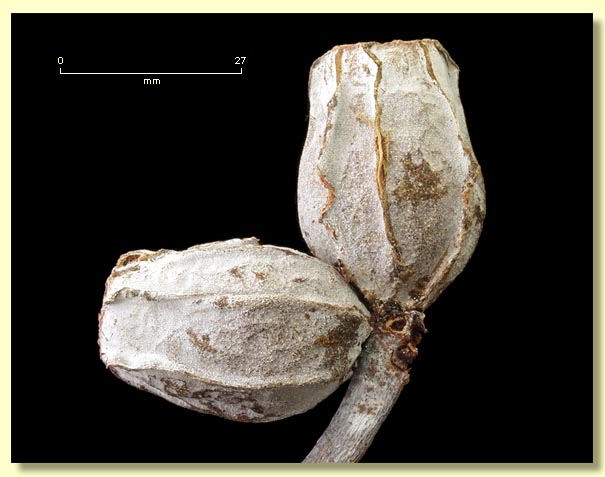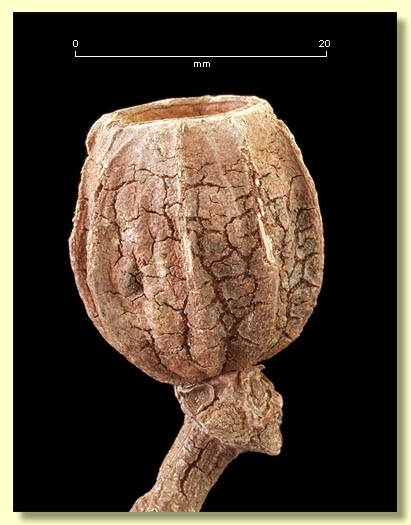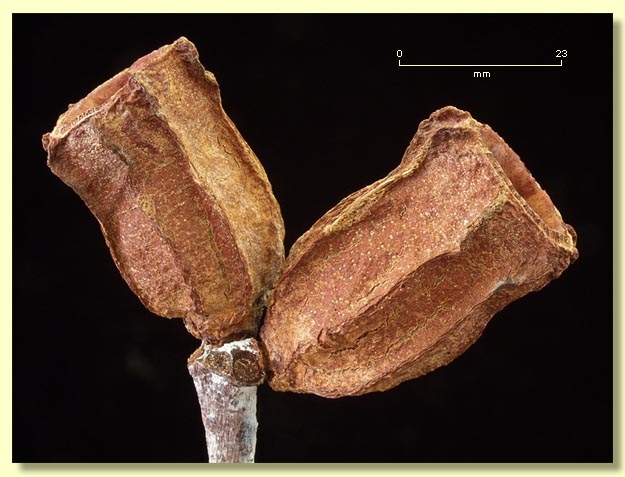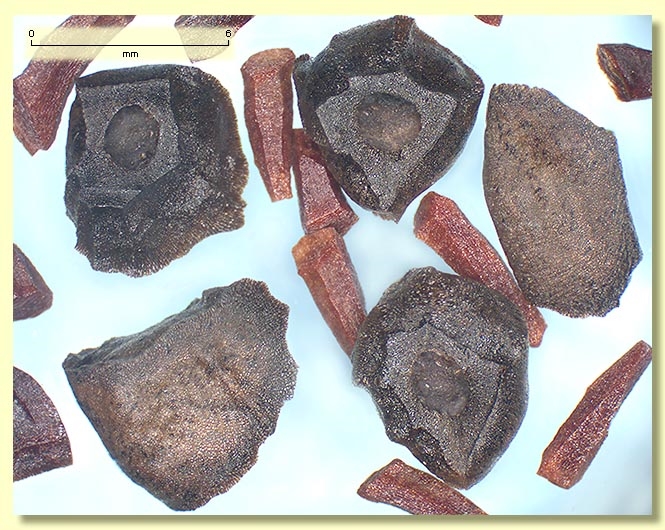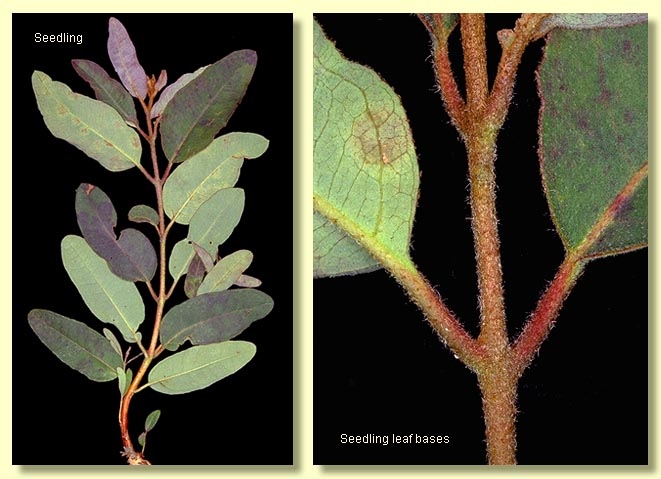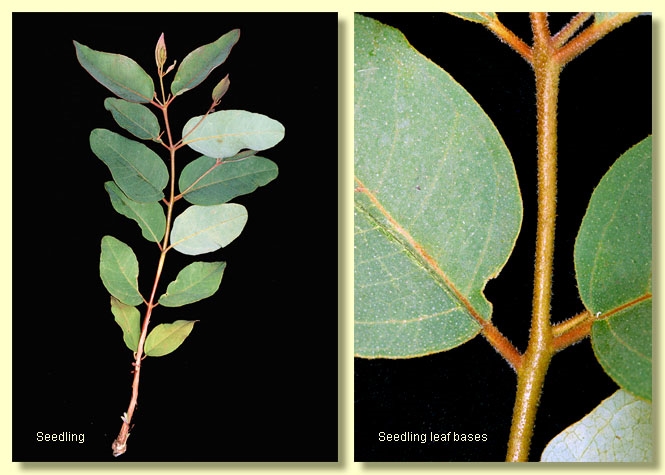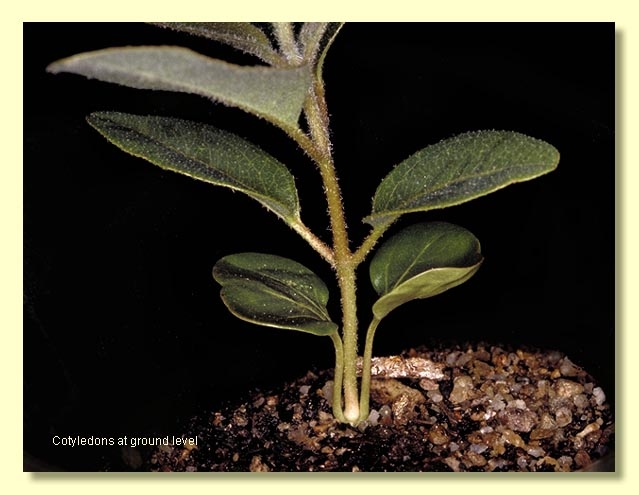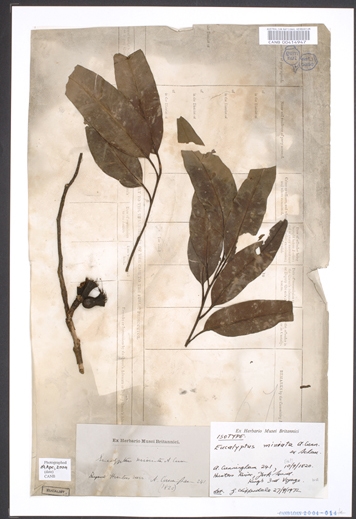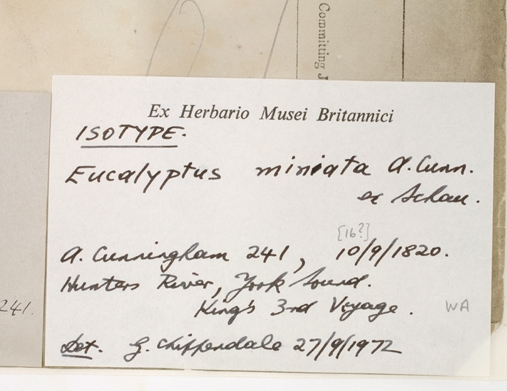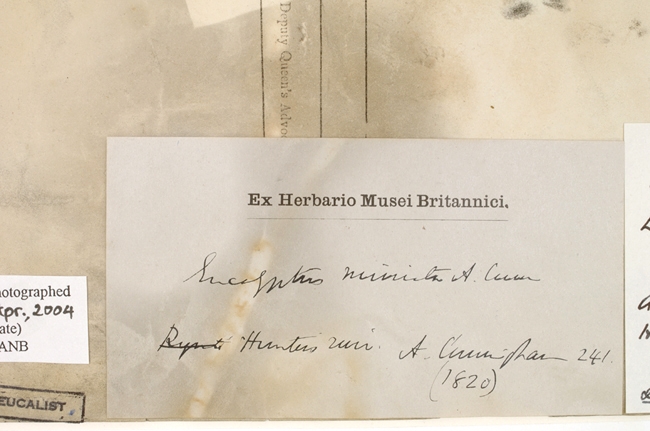Euclid - Online edition
Eucalyptus miniata
Eucalyptus | Eudesmia | Reticulatae | Miniatae | Inclinatae
Eucalyptus miniata A.Cunn. ex Schauer in W.G. Walpers, Repert. Bot. Syst. 2: 925 (1843).
T: Hunter River, York Sound, Western Australia, 16 Sept 1820, A.Cunningham 241; iso: BM, CANB, K.
Tree to 30 m tall. Forming a lignotuber.
Soft papery, fibrous rough bark over most the trunk, rough bark orange-brown to red-brown to yellow-brown to dark grey. Upper trunk and large branches with white to pale grey smooth bark.
Branchlets glaucous with oil glands in the pith.
Juvenile growth (coppice or field seedlings to 50 cm): stems rounded in cross-section, hairy; juvenile leaves opposite and petiolate, ovate to broadly lanceolate, 5.5–12 cm long, (2)3.5–6.5 cm wide, base rounded to truncate to shallowly lobed, apex acute to rounded, dull green, with hairs.
Adult leaves alternate petioles 1.2–2.7 cm long; blade lanceolate to broadly lanceolate, 7–16(18) cm long, (2)2.5–4.5(6) cm wide, base rounded to tapering to petiole, discolorous, dull to slightly glossy green, side-veins at a wider angle than 45° to the midrib, tertiary venation moderate to dense, intramarginal vein present and very close to the margin, oil glands island and intersectional.
Inflorescence axillary single, peduncles 1–3.5 cm long, buds 7 per umbel, usually pedicellate, sometimes sessile, pedicels 0–0.7 cm long. Mature buds clavate to rarely broadly fusiform (1–2.3 cm long, 0.9–1.2 cm wide), glaucous, calyx fused to the corolla and evident as 4 small teeth at the apex of the bud, hypanthium longitudinally striated or ribbed, operculum rounded to conical, stamens usually inflexed but occasionally irregularly flexed, anthers oblong, versatile, dorsifixed, dehiscing by longitudinal slits (non-confluent), style long, hooked or bent beneath the apex of the bud, stigma tapered, locules usually 3, the ovules usually arranged in 6 distinct vertical rows on the placentae. Flowers orange.
Fruit sessile or shortly pedicellate, pedicels 0–0.3 cm long, cylindrical to barrel-shaped to urceolate, longitudinally ribbed, 3.3–6 cm long, (1.8)2–4 cm wide, young fruit glaucous, but glaucescence weathering with age, disc vertically to obliquely descending, valves 3, enclosed.
Seeds dull dark grey to black, ± flattened to obliquely pyramidal to ± cuboid, 4–7 mm long, ventral surfaced ribbed, dorsal surface smooth, hilum ventral, often indented.
Cultivated seedlings (measured at node 10): cotyledons reniform to bilobed, c. 2 cm wide and emerging from the stem at ground level; stems round in cross-section, hairy; leaves always petiolate, opposite, ovate to broadly lanceolate, 5.5–10 cm long, (2.1)2.5–5.5 cm wide, base rounded or tapering, apex rounded or bluntly pointed, margins sometimes appear toothed due to the hairs, blue-green to green, discolorous, lamina hairy on both sides,.
Flowering has been recorded in January, April, May, June, July, August and September.
A medium-sized to tall tree, common right across northern Australia from the Kimberley in Western Australia through the Top End of the Northern Territory to just across the border into the Burketown region of north Queensland. E. miniata is most common in open forest or woodlands with deep sandy soils but can also be found growing in shallow soils on the tops or sides of sandstone escarpments. It is charactised by its rough, papery or fibrous bark on the trunk and the smooth, white bark on the upper trunk and branches, the discolorous adult leaves, the glaucous buds, the bright orange filaments of the flower and the large ribbed fruit.
It belongs to the taxonomically complex subgenus Eudesmia and is included in the section Reticulatae, series Miniatae, subseries Inclinatae characterised by having the calyx fused to the corolla and evident as four small teeth at the apex of the bud, hairy seedlings, adult leaf reticulation relatively dense, buds with a long style and bright orange flowers. It is closest to E. gigantangion from the Kakadu National Park area of the Northern Territory and E. chartaboma from the Croydon to southern Cape York Peninsula area of north Queensland, both members of the subseries Inclinatae. E. gigantangion can be distinguished by its narrower adult leaves and its non-glaucous buds and fruits (adult leaves in E. gigantangion 1–2 cm wide and in E. miniata 2–4.5 cm wide). E. chartaboma is distinguished by its paler, flaky, papery yellow-brown to pink-brown rough bark and its narrow adult leaves, 1.3–2.5 cm wide.
E. phoenicea and E. ceracea, two other members of the subseries Inclinatae, are relatively close to E. miniata. E. phoenicea can be distinguished by normally having more than 15 buds to each umbel and by having narrower cylindrical to urn-shaped fruit to 1.3 cm wide. (E. miniata has seven-budded umbels and large fruit, always wider than 2.2 cm.) E. ceracea can be distinguished by consistently having a mature crown of glaucous, ovate juvenile leaves.
E. miniata, with its soft, rough, fibrous, papery bark on the lower trunk and its contrasting white to pale grey, smooth bark on the upper trunk and branches, and its bright orange flowers, should not be confused with any other eucalypt, other than those discussed above.
Eucalyptus miniata: Latin miniatus, satin-red, flame-scarlet, referring to the colour of the filaments on the flower.

